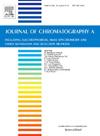Ultrasound-assisted rapid growth of chemically bonded bifunctional mesoporous covalent organic framework submicrospheres on a nickel-chromium alloy support for efficient solid-phase microextraction of bisphenols from water and milk samples
IF 3.8
2区 化学
Q1 BIOCHEMICAL RESEARCH METHODS
引用次数: 0
Abstract
A layer-by-layer chemical bonding strategy was developed for fast in situ growth of bifunctional mesoporous covalent organic framework submicrospheres (COF SMSs) on the nickel-chromium alloy (Ni-Cr) fiber substrate via the ultrasound-assisted Schiff-base reaction for the first time. COF SMSs showed well-defined morphology, extraordinary high surface area (1211 m2·g−1) and narrow mesopore (2.50 nm) as well as excellent stability. Furthermore, the resulting Ni-Cr fiber presented outstanding adsorption capability and improved selectivity for bisphenols (BPs). Consequently, an attractive SPME-HPLC-UV approach with the Ni-Cr@Ni-Cr LDHs NSs@COF SMSs fiber was proposed for rapid preconcentration and sensitive determination of BPs. By optimizing adsorption parameters, the SPME-HPLC-UV method presented good linearity for five BPs in the ranges of 0.02–200 ng·mL−1 with coefficients of determination (R2) higher than 0.999. Limits of detection and limits of quantitation were obtained from 0.003 ng·mL−1 to 0.006 ng·mL−1 and from 0.010 to 0.019 ng·mL−1, respectively. Moreover, the intra-day and inter-day precision expressed as relative standard deviations (RSDs) was 1.57–3.52 % and 2.65–4.38 % for the proposed method with a single fiber, respectively. RSDs of the proposed method with different duplicate fibers were 3.25–6.72 %. The proposed SPME-HPLC-UV method was available for efficient preconcentration and sensitive detection of five BPs from real water and milk samples. The relative recoveries at three spiking levels of BPs were achieved in the range of 80.00–118.8 % with RSDs below 7.81 %. In addition, the prepared fiber still exhibited satisfactory adsorption performance after 120 adsorption-desorption cycles.
超声波辅助双功能化学键介孔共价有机框架亚微球在镍铬合金载体上的快速生长,用于从水和牛奶样品中高效固相微萃取双酚
通过超声辅助席夫碱反应,首次在镍铬合金(Ni-Cr)纤维基底上开发了一种逐层化学键策略,用于快速原位生长双功能介孔共价有机框架亚微球(COF SMSs)。COF SMSs 形状清晰,具有超常的高比表面积(1211 m2-g-1)和窄中孔(2.50 nm),且稳定性极佳。此外,所制备的镍铬纤维具有出色的吸附能力,并提高了对双酚(BPs)的选择性。因此,利用 Ni-Cr@Ni-Cr LDHs NSs@COF SMSs 纤维进行快速预富集和灵敏测定双酚的 SPME-HPLC-UV 方法极具吸引力。通过优化吸附参数,SPME-HPLC-UV方法在0.02-200 ng-mL-1范围内对5种BPs具有良好的线性关系,测定系数(R2)大于0.999。检出限和定量限分别为 0.003 ng-mL-1 至 0.006 ng-mL-1 和 0.010 至 0.019 ng-mL-1。此外,使用单根纤维的拟议方法的日内和日间精密度(以相对标准偏差(RSD)表示)分别为 1.57%-3.52% 和 2.65%-4.38%。使用不同重复纤维的拟议方法的 RSD 为 3.25-6.72%。所提出的SPME-HPLC-UV方法可用于实际水和牛奶样品中5种溴化萘的高效预浓缩和灵敏检测。在三个添加水平下,BPs的相对回收率为80.00-118.8%,RSD低于7.81%。此外,所制备的纤维在经过 120 次吸附-解吸循环后仍具有令人满意的吸附性能。
本文章由计算机程序翻译,如有差异,请以英文原文为准。
求助全文
约1分钟内获得全文
求助全文
来源期刊

Journal of Chromatography A
化学-分析化学
CiteScore
7.90
自引率
14.60%
发文量
742
审稿时长
45 days
期刊介绍:
The Journal of Chromatography A provides a forum for the publication of original research and critical reviews on all aspects of fundamental and applied separation science. The scope of the journal includes chromatography and related techniques, electromigration techniques (e.g. electrophoresis, electrochromatography), hyphenated and other multi-dimensional techniques, sample preparation, and detection methods such as mass spectrometry. Contributions consist mainly of research papers dealing with the theory of separation methods, instrumental developments and analytical and preparative applications of general interest.
 求助内容:
求助内容: 应助结果提醒方式:
应助结果提醒方式:


